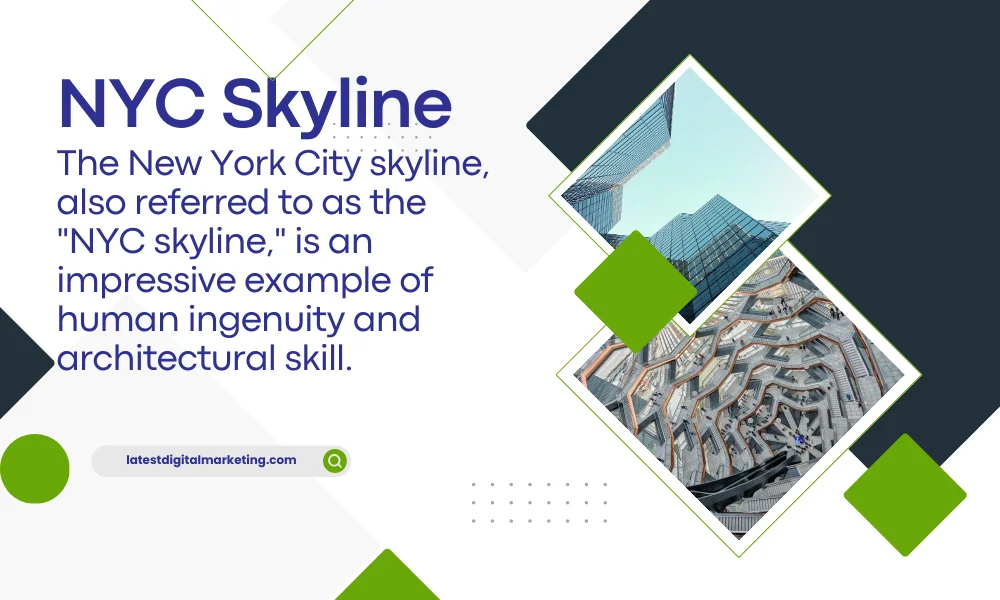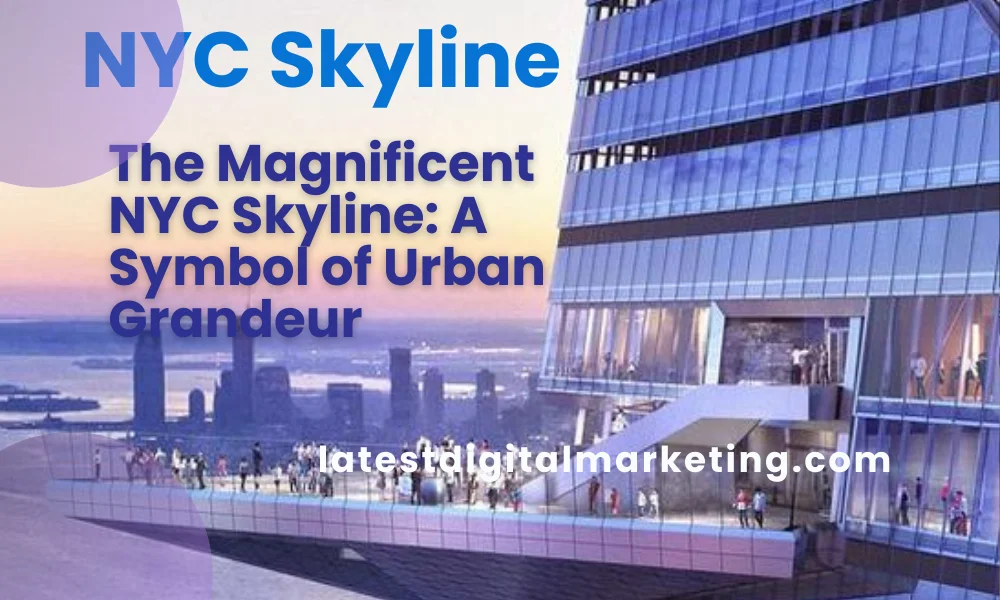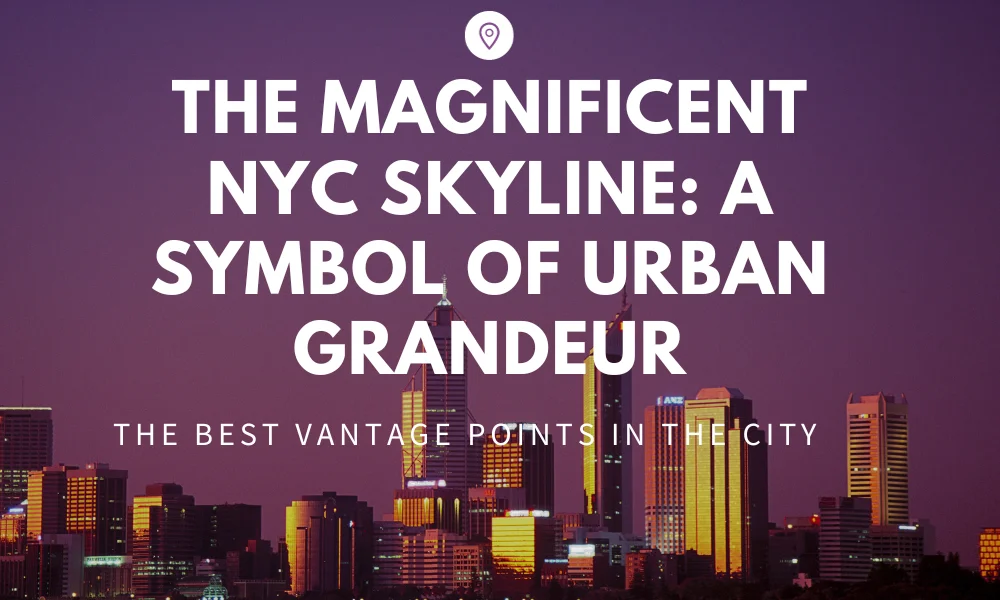NYC Skyline
The Magnificent NYC Skyline: A Symbol of Urban Grandeur (NYC Skyline)
Introduction
The New York City skyline, often referred to simply as the “NYC skyline,” is an awe-inspiring testament to human innovation and architectural prowess.
This iconic silhouette, recognized worldwide, embodies the city’s spirit of ambition, diversity, and progress.
In this article, we delve into the history, evolution, and significance of the NYC skyline, exploring the iconic skyscrapers that define it and the cultural impact it has had.
(NYC Skyline)

A Brief Historical Overview (NYC Skyline)
The history of New York City’s skyline begins in the late 19th century, when steel-framed skyscrapers first started to change the cityscape. The development of steel frame construction methods enabled for the construction of the first skyscrapers, including the famous Flatiron Building, in 1902.
The Woolworth Building’s 1913 completion, however, was what really signaled the start of the city’s rise into the vertical sphere.
The New York City skyline, also known as the “NYC skyline,” is a breathtaking example of human ingenuity and architectural skill. This instantly recognizable silhouette captures the aspirational, diverse, and forward-thinking attitude of the city.
In this article, we explore the iconic buildings that form the New York City skyline, its evolution, and its significance, as well as the cultural effects it has had.
Why Is New York City’s Skyline So Famous? 17 Structures to Know
New York City’s skyline is the most recognizable skyline in the world. According to critic Eric P. Nash, author of the upcoming book Sky-High: A Critique of NYC’s Supertall Towers from Top to Bottom (Princeton Architectural Press, $40), the Big Apple is known for its many outstanding architectural firsts as well as potentially some hopeful architectural lasts.
Chicago may have pioneered the skyscraper, but New York popularized it before pushing it to the limit with the development of the super-tall. These new points of attraction in the built environment are these pencil-thin towers.
But they are also very clear indicators of excessive wealth.
“The mixed-use, sky-high super-tall is the building typology of the twenty-first century,” claims Nash in Sky-High. Few hotshot architects are focusing on anything else, with the exception of museum construction, which has a certain air of status.
These rising stars in New York City include Adrian Smith and Gordon Gill, James von Klemperer of Kohn Pedersen Fox Associates, and SHoP Architects.
A large number of them have designed skyscrapers for the area’s now-famous Billionaire’s Row on 57th Street.
The iconic urban silhouette that we currently associate with the city has been shaped by super-tall buildings and their historic neighbors. Learn more about their rise in the sections below. (NYC Skyline)

30 Hudson Yards
The towers of the brand-new Hudson Yards development, which caps a trainyard, have been visible on the skyline since its introduction in 2019.
The outdoor observation deck at the extremely tall office building 30 Hudson Yards, designed by Kohn Pedersen Fox, is undoubtedly noticeable.
The glass tower with duck-beaked heads rises 1,296 feet altogether, with the glass-bottomed platform at 1,100 feet above the earth. Construction on the second phase of this exclusive neighborhood is about to begin. (NYC Skyline)
432 Park Avenue
432 Park Avenue The 1,396-foot-tall residential tower by Rafael Violy, which caused controversy when it debuted in 2015 due to its height and design, was briefly the tallest building in the world and was among the first of the super-tall buildings that are now common in New York City.
Its concrete façade, which rises from a square floor plate, creates a lattice of square windows spanning all 84 stories. These 84 stories also have a number of open air, double-height mechanical areas that let wind move through the structure and lessen its sway.
The condominium’s board filed a lawsuit against the building’s developers, CIM Group and Macklowe Properties, in 2021 after learning that the structure had not been built in accordance with Violy’s blueprints, leading to mechanical problems that are now affecting many buildings across the world. (NYC Skyline)
One World Trade Center
New York City made a commitment to rebuilding the downtown World Trade Centre complex as a representation of the resilience of the city following the devastating terrorist attacks of 9/11. Developer Larry Silverstein ultimately selected David Childs of SOM as the architect for the minimalist tower built today following an architectural competition in which Daniel Libeskind’s design was declared the winner.
The office tower is currently the highest structure in the Western Hemisphere, standing 1,776 feet tall with its spire—a symbolic height related to the year the US signed the Declaration of Independence.

Woolworth Tower
One of the first skyscrapers in New York City, this terra cotta-covered 1913 tower by Cass Gilbert once held the record for height until 1930. Its steel structure design, a cutting-edge modern technology at the time, allows for thinner outer walls and maximizes space in the elaborate Art Deco interior, making it a handsome example of neo-Gothic architecture.
A trip to Europe spurred the building’s owner, F. W. Woolworth, to increase the roof’s height from its original 550 feet to 620 feet, then to 792 feet in order to surpass the MetLife Building, which held the record at the time. (NYC Skyline)
56 Leonard Street
This Tribeca apartment tower by Herzog & de Meuron, also known as the Jenga Building because of the way its upper floors appear to be stacked haphazardly, first appeared on the skyline in 2017. The eye-catching 57-story tower, the tallest in the area, is made up of those distinct rectangular volumes as individual houses.
The final component of the design, a 19-foot scale replica of Anish Kapoor’s Cloud Gate sculpture, was put in place at the base of the structure this year. Chicago is home to the first jelly bean. (NYC Skyline)
Steinway Tower
Empire State Building
If you can make out the distinctive spire of this structure, you are in New York City. Up until 2012, the city’s highest building was the 102-story Shreve, Lamb, and Harmon Art Deco skyscraper, which was finished in 1931.
Its form was altered numerous times as it competed to be the tallest structure in the world, and its observation decks on the 80th, 86th, and 102nd floors still draw tourists from all over the world today. It is covered in ornamental limestone.
MetLife Building
The 1962 completion of this skyscraper in the International Style designed by Pietro Belluschi, Walter Gropius, and Richard Roth close to New York’s Grand Central Terminal. The elongated octagonal design of the 59-story office skyscraper, which was once the Pan American World Airways headquarters, is intended to assist down its perceived scale.
The MetLife Building has drawn criticism since it was first proposed because of its proximity to the historic train station, to which its lobby serves as a pedestrian passageway.
However, as one of New York City’s first structures to use precast concrete exterior walls, it also represents a feat of architecture. (NYC Skyline)
Chrysler Building
This iconic Art Deco tower was not always as well-liked on the New York City skyline as it is today. It was created by architect William Van Alen and finished just one year before the Empire State Building.
It was the first skyscraper with a decorative, non-functional top, commissioned by Walter Chrysler of the self-titled car manufacturer, and received mixed reviews from architectural critics. The Chrysler Building is still the highest brick building with a steel frame in the world, despite the Empire State overtaking it as the tallest skyscraper in NYC after only 11 months.
40 Wall Street
This 1929–1930 copper-capped tower in New York City’s Financial District competed fiercely to be not just the city’s but also the world’s tallest structure, alongside the Empire State and Chrysler buildings.
Despite the fact that 40 Wall Street ultimately fell short of its rivals, the city skyline is nonetheless enhanced by the building’s neo-Gothic shape and oxidized pyramidal top. The office tower’s terra-cotta and brick exterior was created by the H.
Craig Severance, Yasuo Matsui, and Shreve & Lamb architectural collective. (NYC Skyline)
Seagram Building
The 1958 Seagram Building, a glass and black steel obelisk in midtown Manhattan, is the first and only New York City-based design by Ludwig Mies van der Rohe.
The International Style building’s rational design includes a tower on piloti columns with a sizable public plaza at the ground level. However, it should be noted that there is nowhere for the public to sit in this plaza.
The design provides a smaller building on a larger site as opposed to embracing in-tower setbacks to meet with zoning requirements, as many of its neighbors before and after have done. Since then, numerous other structures have been influenced by it. (NYC Skyline)
Central Park Tower
The world’s tallest residential tower, this 1,550-foot structure on Billionaire’s Row was designed by Adrian Smith and Gordon Gill Architecture. When it is finished in 2020, the Central Park Tower will cantilever over the historic Art Students League of New York on one side to give occupants the best possible view of the surrounding Central Park.
Critics haven’t been won over by its boxy design, though; as Nash states in Sky-High: “It holds all the charm of a pair of bundled cartons.”
Citigroup Center
Hugh Stubbins’ unusual triangle top was originally intended to support terraces for 100 apartments when the office tower in midtown Manhattan was built in 1977, and afterwards it used as a field for solar panels.
The building was the first postmodern structure with a purely decorative roof after both designs were abandoned. St. Peter’s Lutheran Church, a small church in the same design as the tower that took its place before completion, is located in one corner of its base, sitting atop sturdy piloti.
Diane Hartley, an engineering student at Princeton University, discovered a problem with the tower’s design a year after Citigroup Centre opened: Under a particular set of practicable wind conditions, it was not structurally sound. There were swift (and quiet) reinforcements.
53W53
The Museum of Modern Art in New York City received a new tower along with its most recent expansion in 2019. Luxury apartments make up the majority of this 82-story skyscraper by Jean Nouvel, but it also has new galleries and a cafeteria for the nearby museum.
Critics have generally praised Nouvel’s triangulated design, which is visible through a concrete diagrid on the building’s façade and results in some peculiarly shaped living areas and dramatic corners in apartments on the upper floors, and have even defended it when protests over its height forced the originally planned 1,250-foot-tall skyscraper to be reduced by 200 feet.
One Vanderbilt
In 2020, Kohn Pedersen Fox’s 93-story glass and terra-cotta super-tall office tower opened across from Grand Central Terminal, serving as the MetLife Building of the twenty-first century.
Between 42nd and 43rd streets on Vanderbilt Avenue became pedestrianised as a result of its development. The architects assert that the historic train station’s façade design served as inspiration, but not all detractors agree.
According to Nash, “contextual gestures towards its stately neighbor…are rudimentary.” “One thing can be said about One Vanderbilt: It’s big.”
Rockefeller Center
Nineteen buildings make up this historic office complex on 22 acres in Midtown Manhattan, but the 14 original Art Deco structures, all finished in the 1930s during the Great Depression, are its most famous. Between 40,000 and 60,000 people worked on the campus buildings, whose centerpiece is the 850-foot-tall 30 Rockefeller Plaza, designed in the Art Deco style and built by architect Raymond Hood
The Brooklyn Tower
Although Brooklyn has just entered the ranks of tower superlatives, Manhattan has long been the architect’s playground for sky-high towers.
The Dimes Savings Bank from the 1900s serves as the foundation for a 93-story, 1,066-foot-tall residential tower being built by SHoP Architects at 9 DeKalb Avenue in downtown Brooklyn. The first super-tall building in Brooklyn is hexagonal in shape and is covered in stainless steel, stone and bronze as it rises from the bank roof.
The Empire State Building: A Symbol of Greatness
The Empire State Building must be mentioned in any discussion of the NYC skyline. This architectural wonder, which was finished in 1931 amid the height of the Great Depression, was the highest structure in the world for almost 40 years.
It has become an enduring symbol of the city thanks to its distinctive Art Deco style and recognizable spire.
One World Trade Center: Resilience and Remembrance
The city’s skyline and the sad events of September 11, 2001, are forever changed. One World Trade Centre was built as a testament to resiliency and memory after the old World Trade Centre towers were destroyed.
When this 1,776-foot-tall building was finally finished in 2013, it not only restored the city’s skyline but also served as a somber memorial to the lives lost.
Diversity in Architecture
The diversity of the city’s architectural styles is one of its most noticeable characteristics.
The skyline of the city features a diverse range of architectural styles, reflecting the city’s active past and constantly changing character, from the Gothic-inspired spire of the Chrysler Building to the sleek, contemporary lines of the Bank of America Tower.
Cultural Impact
The New York City skyline has had a major cultural influence. It has appeared in innumerable movies, shows on television, and works of art, and has come to represent American culture and urban life.
Its towering majesty has served as a source of inspiration for writers, artists, and photographers who have attempted to convey it in many ways.
The Nighttime Spectacle
The NYC skyline is stunning during the day, but at night everything comes to life. Millions of lights are placed atop the city’s buildings, creating a stunning spectacle that can be seen for miles.
The city’s enjoyment of its recognisable skyline is shown in the yearly Fourth of July fireworks display above the cityscape.
Conclusion
The skyline of New York City is more than just a group of structures; it is a symbol of human creativity, tenacity, and ambition. It symbolises the ever changing narrative of New York City, a city that keeps reaching for the stars in its quest for innovation and growth.
The New York City skyline will continue to be a representation of metropolitan grandeur and a source of inspiration for future generations as long as there are visionaries and builders.
The skyline of New York City is more than just a group of structures; it is a symbol of human creativity, tenacity, and ambition. It symbolises the ever changing narrative of New York City, a city that keeps reaching for the stars in its quest for innovation and growth.
The New York City skyline will continue to be a representation of metropolitan grandeur and a source of inspiration for future generations as long as there are visionaries and builders.
FAQs (NYC Skyline)
- What are some of the most iconic buildings in the NYC skyline? The Empire State Building, One World Trade Centre, the Chrysler Building, and the Flatiron Building are just a few of the famous structures that make up the NYC skyline.
- How has the NYC skyline influenced popular culture? The New York City skyline has been featured in numerous films, TV series, and works of art, having a significant influence on popular culture. It represents the very best of urban aspiration and existence.
- What is the significance of the Empire State Building in the NYC skyline? The Empire State Building, which was once the highest structure in the world, is a symbol of the ambition and tenacity of the metropolis. It’s a recognizable image of New York City.
- How did the 9/11 attacks impact the NYC skyline? The Twin Towers were destroyed as a result of the 9/11 attacks, but they also sparked the building of One World Trade Centre, which now stands as a memorial and a sign of optimism.
- Are there any new developments in the NYC skyline worth mentioning? The Central Park Tower and 432 Park Avenue, two recent additions to the skyline, are both renowned for their cutting-edge designs and magnificent vistas.

